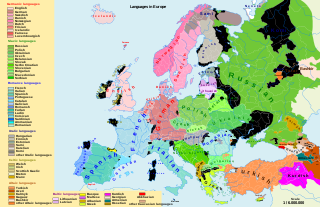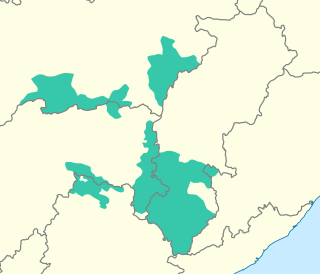Related Research Articles

There are over 250 languages indigenous to Europe, and most belong to the Indo-European language family. Out of a total European population of 744 million as of 2018, some 94% are native speakers of an Indo-European language. The three largest phyla of the Indo-European language family in Europe are Romance, Germanic, and Slavic; they have more than 200 million speakers each, and together account for close to 90% of Europeans.
Maria language may refer to:
Allar is a Dravidian language spoken in Kerala, India. Due to a lack of scholarly study, Allar cannot be classified within Dravidian at this time and may be a dialect of some other Dravidian language.

Gondi (Gōṇḍī), natively known as Koitur, is a South-Central Dravidian language, spoken by about three million Gondi people, chiefly in the Indian states of Madhya Pradesh, Maharashtra, Chhattisgarh, Andhra Pradesh, Telangana and by small minorities in neighbouring states. Although it is the language of the Gond people, it is highly endangered, with only one fifth of Gonds speaking the language. Gondi has a rich folk literature, examples of which are wedding songs and narrations. Gondi people are ethnically related to the Telugus.

The main languages spoken in Sri Lanka are Sinhala and Tamil. Several languages are spoken in Sri Lanka within the Indo-Aryan, Austronesian, and Dravidian families. Sri Lanka accords official status to Sinhala and Tamil, and English as a recognised language. The languages spoken on the island nation are deeply influenced by the various languages in India, Europe and Southeast Asia. Arab settlers and the colonial powers of Portugal, the Netherlands and Britain have also influenced the development of modern languages in Sri Lanka. See below for the most-spoken languages of Sri Lanka.
Kui (କୁଇ)(also Kandh, Khondi, Khond, Khondo, Kanda, Kodu, Kodulu, Kuinga, Kuy) is a South-Central Dravidian language spoken by the Kandhas, eastern Indian state of Odisha. It is mostly spoken in Odisha, and written in the Odia script. With 941,988 registered native speakers, it figures at rank 29 in the 1991 Indian census. The Kui language was also referred to as the Kuinga language during the historical period. It is closely related to the Gondi and Kuvi languages.
Koya is a South-Central Dravidian language of the Gondi–Kui group spoken in central and southern India. It is the native language of the Koya people. It is sometimes described as a dialect of Gondi, but it is mutually unintelligible with Gondi dialects.
Nagarchal is an unattested extinct language of central India, presumed to be Dravidian. According to the 1971 census, there were 7,100 speakers of the language, but they have since apparently shifted to Hindi and Gondi. The Nagarchi people, who formerly spoke it, are found in the Balaghat, Chhindwara, Jabalpur, Mandla and Seoni districts of Madhya Pradesh. In an interview, Nagarchis said that their language was purani bhasha, which means "old language", that they shifted to Hindi and Gondi 15 to 20 years ago and they do not use the language even in the home domain at present. They said the language is very different from Hindi but close to Gondi implying its likely a Gondic language. The researchers attempted to collect Nagarchi wordlists from many areas but this was not possible, even elders were not able to provide wordlists in the Nagarchi language.
Zeem, or Chaari, is an endangered Chadic dialect cluster of Nigeria, whose speakers are shifting to Hausa. Dyarim is closely related.
Kugama, also known as Wam (Wã̀m) or Gengle, is an Adamawa language of Nigeria. It is spoken in Mayo-Belwa and Fufore Local Government Areas of Adamawa State. It is classified within the Yendang group of the Adamawa language family.
Muria is a Dravidian language spoken in India. Three varieties have mutual intelligibility. It is sometimes confused with the Madiya language. It is suspected to be mutually unintelligible with northern Gondi dialects.
Lamaholot, also known as Solor or Solorese, is a Central Malayo-Polynesian dialect cluster of Flores, Indonesia. The varieties may not be all mutually intelligible; Keraf (1978) reports that there are 18 languages under the name.
Paliyan is a Dravidian language of Kerala that is closely related to Tamil. It is spoken by the Paliyans.
Kadar is a Dravidian language of Kerala and Tamil Nadu that is closely related to Malayalam.
Mannan is a Dravidian language of Kerala and Tamil Nadu that is classified under the Tamil languages.
Mullu Kurumba is a Southern Dravidian language closely related to Malayalam.
Malasar (Malayar) is a Southern Dravidian language spoken by a Scheduled tribe of India. It is close to Eravallan.
Thachanadan is a Southern Dravidian language spoken by a Scheduled tribe of India. Dissimilar to other Dravidian languages, its most likely affinities are to Mullu Kurumba, with which it has 66-72% lexical similarity.
Pathiya is a Southern Dravidian language of India. It is close to Kalanadi.
References
- ↑ Garhchiroli Maria at Ethnologue (18th ed., 2015) (subscription required)
Dandami Maria at Ethnologue (18th ed., 2015) (subscription required) - 1 2 3 Bhadriraju Krishnamurti (2003). The Dravidian languages . Oxford University Press. pp. 25. ISBN 9780521771115.
- ↑ "First book on Madiya language released in city". 9 July 2019. Archived from the original on 2021-06-07. Retrieved 2023-07-04.